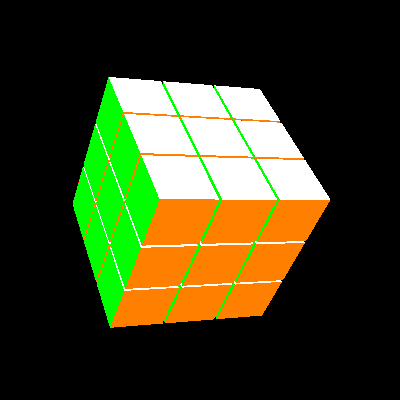魔方可以通过 3x3x3 多维数据集的3维数组来组织。旋转多维数据集的一个切片似乎很容易,但是请注意,如果在切片上旋转,则多维数据集的位置会发生变化,必须重新组织。不仅位置发生变化,(旋转的)单个立方体的方向也发生变化。
首先,从类的构造函数中删除PyGame和OpenGL初始化Cube。这是错误的地方。在下面将生成27个Cube类型的对象。
每个多维数据集都必须知道它最初位于的位置(self.init_i)和经过一些旋转后当前的位置(self.current_i)。该信息被编码为一个包含3个元素的列表,每个元素一个。的值是在该立方体的索引NxNxN 魔方在范围 [0,N [ 。 单个立方体的方向编码为3维旋转矩阵(self.rot)。旋转矩阵必须由恒等矩阵初始化。
class Cube():
def __init__(self, id, N, scale):
self.N = N
self.scale = scale
self.init_i = [*id]
self.current_i = [*id]
self.rot = [[1 if i==j else 0 for i in range(3)] for j in range(3)]
创建27个多维数据集的列表
cr = range(3)
self.cubes = [Cube((x, y, z), 3, scale) for x in cr for y in cr for z in cr]
如果旋转魔方的一部分,则必须检查哪个单个魔方受到了影响。这可以通过检查切片是否与当前位置的旋转轴输入匹配来完成。
def isAffected(self, axis, slice, dir):
return self.current_i[axis] == slice
要旋转立方体,位置和方向必须围绕旋转90°axis。3维旋转矩阵由3个方向向量组成。可以通过交换向量的坐标,并向右旋转结果的x坐标,向左旋转结果的y坐标,来旋转d维向量:
rotate right: (x, y) -> (-y, x)
rotate left: (x, y) -> (y, -x)
由于旋转矩阵的所有向量都在轴对齐的平面中,因此该算法可用于更改立方体的方向和位置。axis旋转轴 (x = 0,y = 1,z = 2) 且dir是旋转方向( 1 右, -1 左)要旋转轴矢量,必须交换矢量的2个分量,并将其中之一反转。
例如,绕Y轴向左旋转:
(x, y, z) -> (z, y, -x)
旋转位置时,必须交换索引。反转索引意味着将索引映射i到索引N-1-i:
例如,绕Y轴向左旋转:
(ix, iy, iz) -> (iz, iy, N-1-ix)
单个立方体的旋转:
i, j = (axis+1) % 3, (axis+2) % 3
for k in range(3):
self.rot[k][i], self.rot[k][j] = -self.rot[k][j]*dir, self.rot[k][i]*dir
self.current_i[i], self.current_i[j] = (
self.current_i[j] if dir < 0 else self.N - 1 - self.current_i[j],
self.current_i[i] if dir > 0 else self.N - 1 - self.current_i[i] )
当必须绘制立方体时,可以使用立方体的当前位置(self.current_i)和方向self.rot来设置4x4转换矩阵:
def transformMat(self):
scaleA = [[s*self.scale for s in a] for a in self.rot]
scaleT = [(p-(self.N-1)/2)*2.1*self.scale for p in self.current_i]
return [
*scaleA[0], 0,
*scaleA[1], 0,
*scaleA[2], 0,
*scaleT, 1]
用glPushMatrix分别glPushMatrix。通过glMultMatrix矩阵可以乘到当前矩阵。 以下函数绘制一个多维数据集。参数angle,axis,slice,dir它甚至可以应用动画的立方体,通过设置animate=True和参数设置angle,axis,slice,dir:
def draw(self, col, surf, vert, animate, angle, axis, slice, dir):
glPushMatrix()
if animate and self.isAffected(axis, slice, dir):
glRotatef( angle*dir, *[1 if i==axis else 0 for i in range(3)] )
glMultMatrixf( self.transformMat() )
glBegin(GL_QUADS)
for i in range(len(surf)):
glColor3fv(colors[i])
for j in surf[i]:
glVertex3fv(vertices[j])
glEnd()
glPopMatrix()
for cube in self.cubes:
cube.draw(colors, surfaces, vertices, animate, animate_ang, *action)
该类的实现Cube适用于任何 NxNxN Rubik的多维数据集。
有关 3x3x3 立方体的信息,请参见示例程序。多维数据集的片由键向右旋转1到9和通过按键左F1到F9:
当然,对于原始代码,该代码使用 旧版 OpenGL。但是该方法Cube.transformMat为单个局部立方体设置了通用的4x4模型矩阵。因此,可以轻松地将此代码移植到现代OpenGL。
import pygame
import random
from pygame.locals import *
from OpenGL.GL import *
from OpenGL.GLU import *
vertices = (
( 1, -1, -1), ( 1, 1, -1), (-1, 1, -1), (-1, -1, -1),
( 1, -1, 1), ( 1, 1, 1), (-1, -1, 1), (-1, 1, 1)
)
edges = ((0,1),(0,3),(0,4),(2,1),(2,3),(2,7),(6,3),(6,4),(6,7),(5,1),(5,4),(5,7))
surfaces = ((0, 1, 2, 3), (3, 2, 7, 6), (6, 7, 5, 4), (4, 5, 1, 0), (1, 5, 7, 2), (4, 0, 3, 6))
colors = ((1, 0, 0), (0, 1, 0), (1, 0.5, 0), (1, 1, 0), (1, 1, 1), (0, 0, 1))
class Cube():
def __init__(self, id, N, scale):
self.N = N
self.scale = scale
self.init_i = [*id]
self.current_i = [*id]
self.rot = [[1 if i==j else 0 for i in range(3)] for j in range(3)]
def isAffected(self, axis, slice, dir):
return self.current_i[axis] == slice
def update(self, axis, slice, dir):
if not self.isAffected(axis, slice, dir):
return
i, j = (axis+1) % 3, (axis+2) % 3
for k in range(3):
self.rot[k][i], self.rot[k][j] = -self.rot[k][j]*dir, self.rot[k][i]*dir
self.current_i[i], self.current_i[j] = (
self.current_i[j] if dir < 0 else self.N - 1 - self.current_i[j],
self.current_i[i] if dir > 0 else self.N - 1 - self.current_i[i] )
def transformMat(self):
scaleA = [[s*self.scale for s in a] for a in self.rot]
scaleT = [(p-(self.N-1)/2)*2.1*self.scale for p in self.current_i]
return [*scaleA[0], 0, *scaleA[1], 0, *scaleA[2], 0, *scaleT, 1]
def draw(self, col, surf, vert, animate, angle, axis, slice, dir):
glPushMatrix()
if animate and self.isAffected(axis, slice, dir):
glRotatef( angle*dir, *[1 if i==axis else 0 for i in range(3)] )
glMultMatrixf( self.transformMat() )
glBegin(GL_QUADS)
for i in range(len(surf)):
glColor3fv(colors[i])
for j in surf[i]:
glVertex3fv(vertices[j])
glEnd()
glPopMatrix()
class EntireCube():
def __init__(self, N, scale):
self.N = N
cr = range(self.N)
self.cubes = [Cube((x, y, z), self.N, scale) for x in cr for y in cr for z in cr]
def mainloop(self):
rot_cube_map = { K_UP: (-1, 0), K_DOWN: (1, 0), K_LEFT: (0, -1), K_RIGHT: (0, 1)}
rot_slice_map = {
K_1: (0, 0, 1), K_2: (0, 1, 1), K_3: (0, 2, 1), K_4: (1, 0, 1), K_5: (1, 1, 1),
K_6: (1, 2, 1), K_7: (2, 0, 1), K_8: (2, 1, 1), K_9: (2, 2, 1),
K_F1: (0, 0, -1), K_F2: (0, 1, -1), K_F3: (0, 2, -1), K_F4: (1, 0, -1), K_F5: (1, 1, -1),
K_F6: (1, 2, -1), K_F7: (2, 0, -1), K_F8: (2, 1, -1), K_F9: (2, 2, -1),
}
ang_x, ang_y, rot_cube = 0, 0, (0, 0)
animate, animate_ang, animate_speed = False, 0, 5
action = (0, 0, 0)
while True:
for event in pygame.event.get():
if event.type == pygame.QUIT:
pygame.quit()
quit()
if event.type == KEYDOWN:
if event.key in rot_cube_map:
rot_cube = rot_cube_map[event.key]
if not animate and event.key in rot_slice_map:
animate, action = True, rot_slice_map[event.key]
if event.type == KEYUP:
if event.key in rot_cube_map:
rot_cube = (0, 0)
ang_x += rot_cube[0]*2
ang_y += rot_cube[1]*2
glMatrixMode(GL_MODELVIEW)
glLoadIdentity()
glTranslatef(0, 0, -40)
glRotatef(ang_y, 0, 1, 0)
glRotatef(ang_x, 1, 0, 0)
glClear(GL_COLOR_BUFFER_BIT|GL_DEPTH_BUFFER_BIT)
if animate:
if animate_ang >= 90:
for cube in self.cubes:
cube.update(*action)
animate, animate_ang = False, 0
for cube in self.cubes:
cube.draw(colors, surfaces, vertices, animate, animate_ang, *action)
if animate:
animate_ang += animate_speed
pygame.display.flip()
pygame.time.wait(10)
def main():
pygame.init()
display = (800,600)
pygame.display.set_mode(display, DOUBLEBUF|OPENGL)
glEnable(GL_DEPTH_TEST)
glMatrixMode(GL_PROJECTION)
gluPerspective(45, (display[0]/display[1]), 0.1, 50.0)
NewEntireCube = EntireCube(3, 1.5)
NewEntireCube.mainloop()
if __name__ == '__main__':
main()
pygame.quit()
quit()


 602392714
602392714
 清零编程群
清零编程群